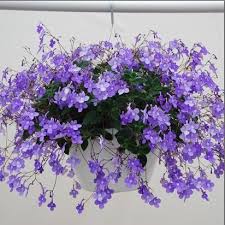 Virtues: Streptocarpella Concord Blue is a tender perennial plant that’s easily kept as a container plant for the garden or as a houseplant—or both! This relative of the African violet can bloom year-round, with dainty purple blossoms rising on airy wands above its furry foliage. In the garden it fills a tricky niche as a shade-loving flowering plant. Indoors, it’s fairly easy to please and free to flower in bright, indirect light.
Virtues: Streptocarpella Concord Blue is a tender perennial plant that’s easily kept as a container plant for the garden or as a houseplant—or both! This relative of the African violet can bloom year-round, with dainty purple blossoms rising on airy wands above its furry foliage. In the garden it fills a tricky niche as a shade-loving flowering plant. Indoors, it’s fairly easy to please and free to flower in bright, indirect light.
StreptoConcordBlue
Common name: Concord Blue streptocarpella or nodding violet
Botanical name: Streptocarpus Concord Blue, Streptocarpella Concord Blue
Exposure: Part or full shade
Flowers: Light purple flowers appear at the tops of thin wand-like stems that rise above the plant’s foliage. The flowers are somewhat reminiscent of violets in shape, but with a long tube between the petals and the flower stem. This plant can bloom all summer, or even year-round if it is wintered as a houseplant where it isn’t hardy.
Foliage: The paired oval leaves are deep green and covered in short hairs that give them a fuzzy, felt like appearance.
Habit: This plant grows as a rounded mound to about 12 inches tall and 15 inches wide. Trailing stems develop particularly if it is grown in a hanging basket.
Origin: Concord Blue is a hybrid of species hailing from subtropical Africa.
How to grow it: Outside in the garden, Concord Blue streptocarpella shows best in an elevated pot, a hanging basket or a roomy window box. It needs a spot in part shade or full shade, a potting mix that drains freely and regular watering. Allow the top inch of soil to dry before watering again. Once a month, use a water-soluble fertilizer high in phosphorus (the middle number) to boost flowering. This plant is hardy in USDA Zones 9–11. Elsewhere it is treated as an annual.
However, Streptocarpella is also simple to keep as a houseplant. Indoors, place it in bright light, but not where the midday sun will strike its leaves, to avoid scorching them. Water regularly but do not allow the soil to stay soggy. This plant is closely related to the African violet; if you’ve had success with those, treat streptocarpella the same way.
www.hortmag.com




